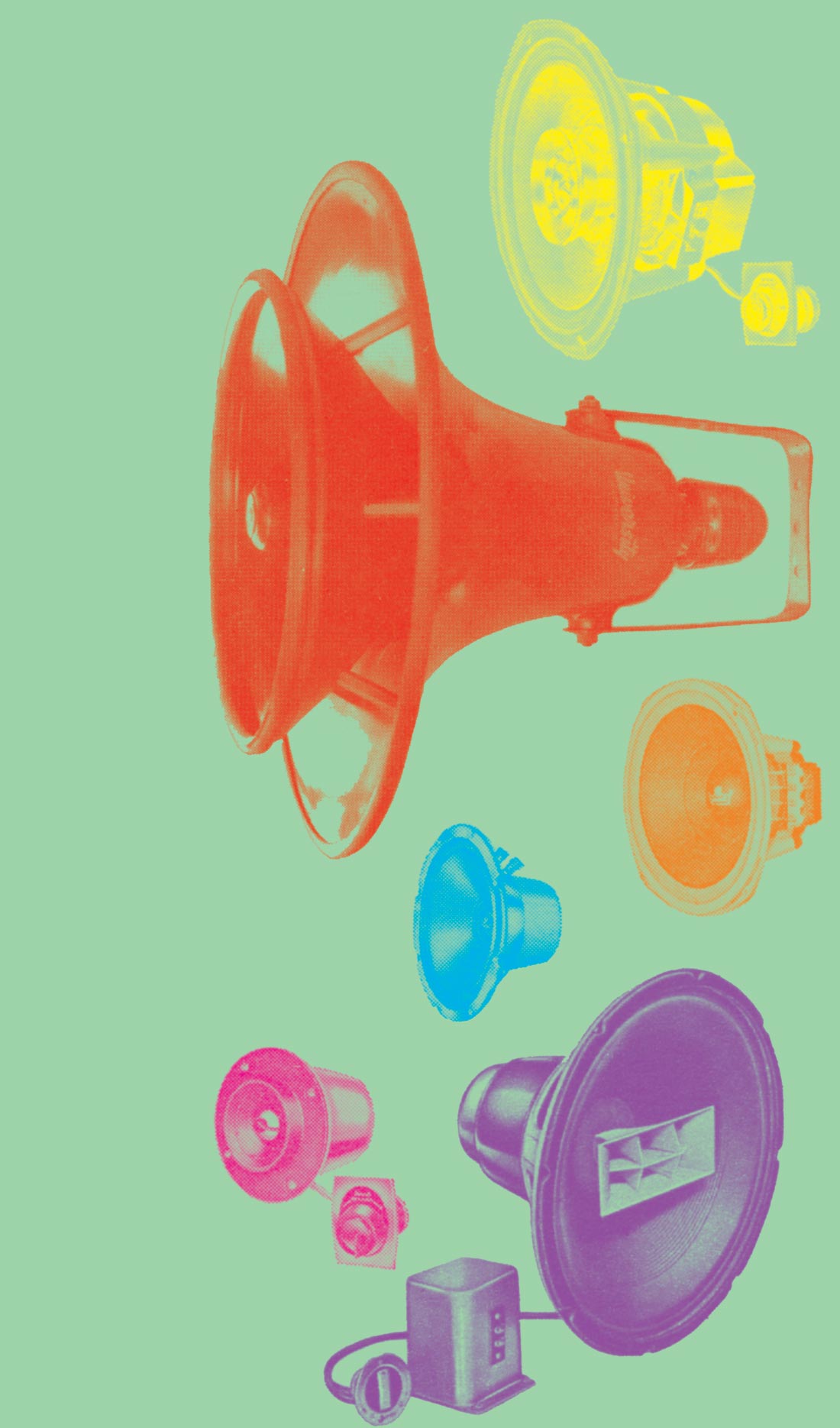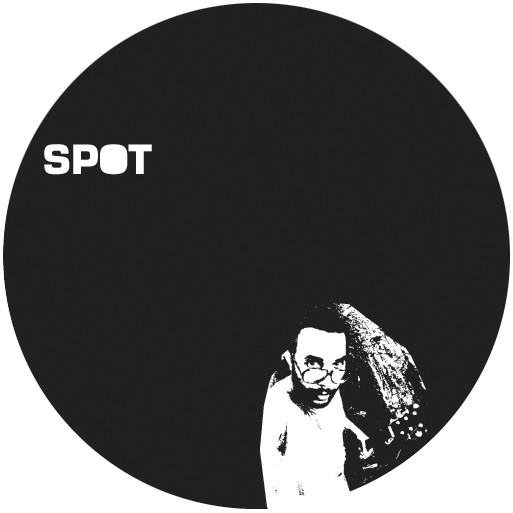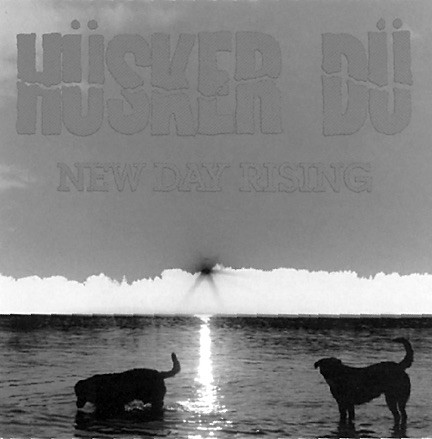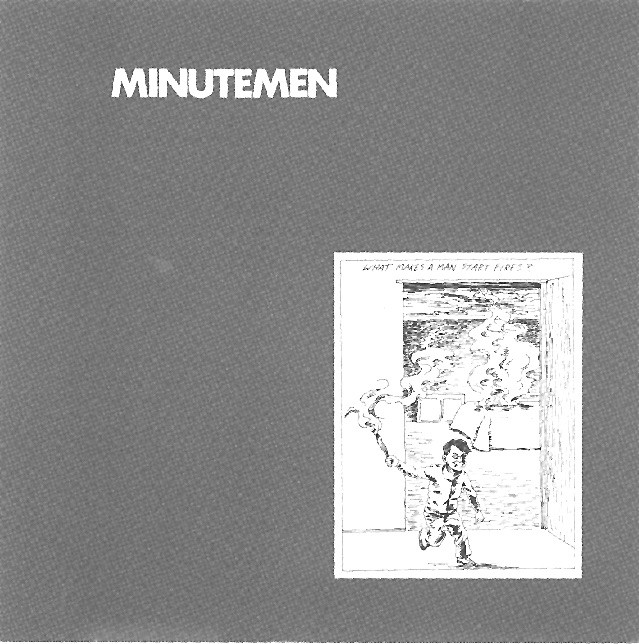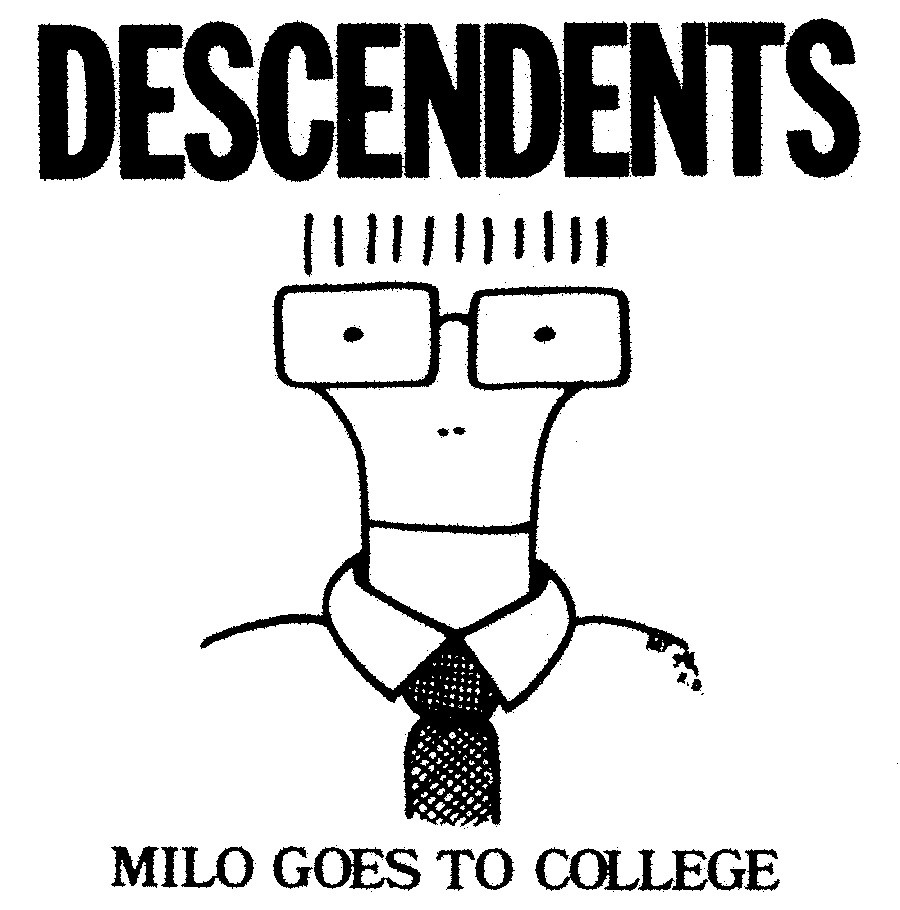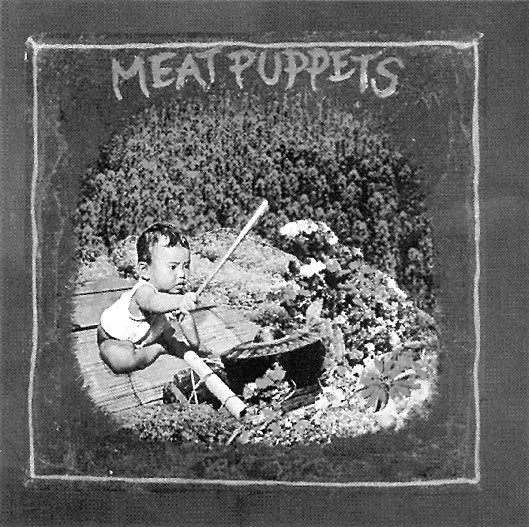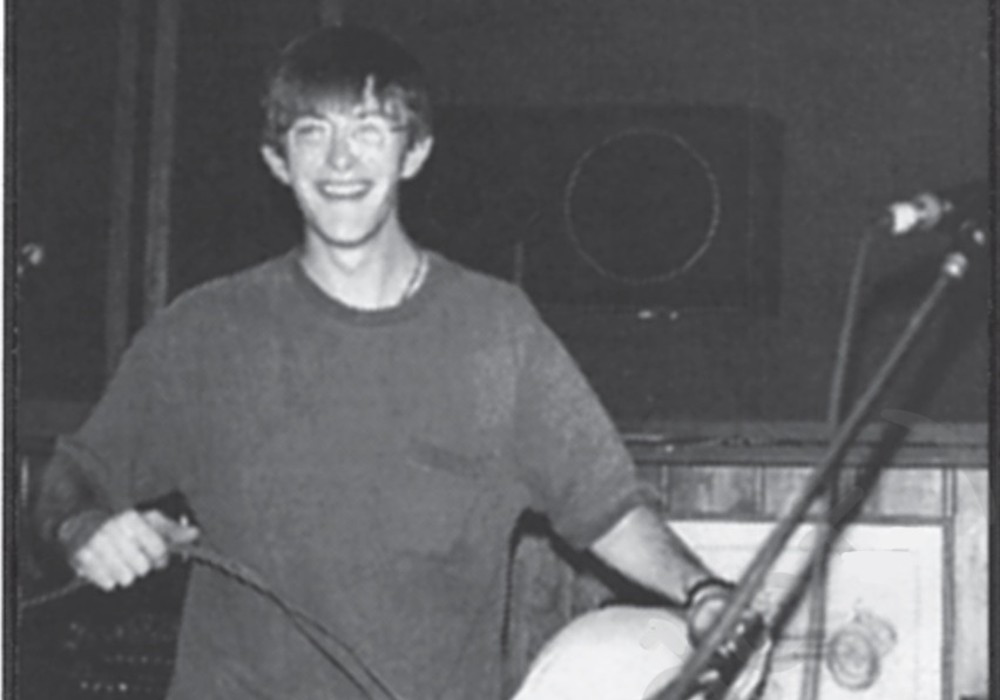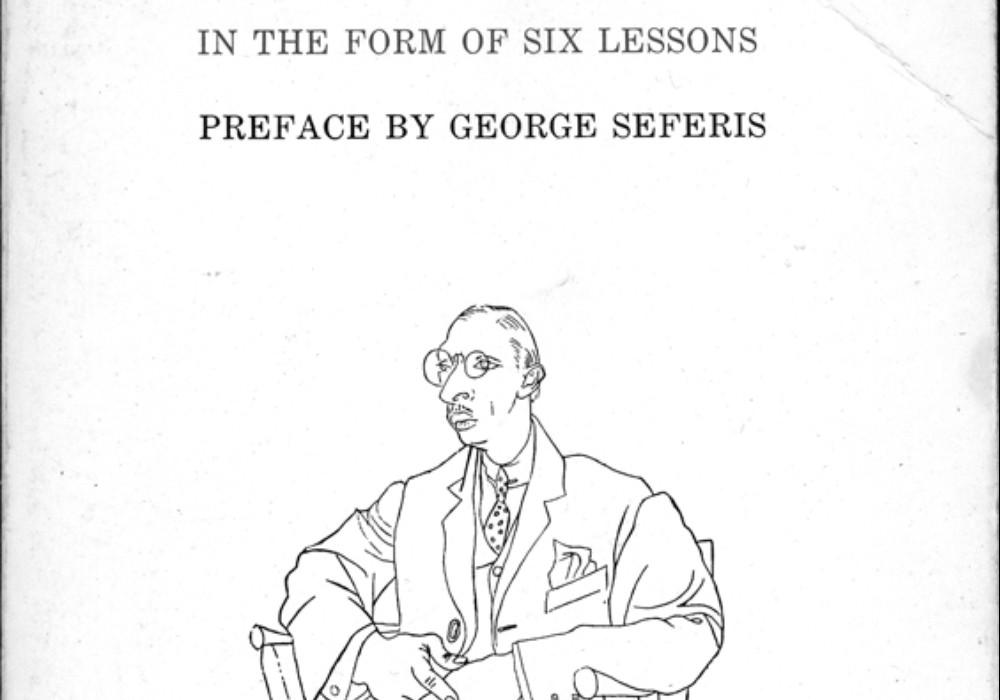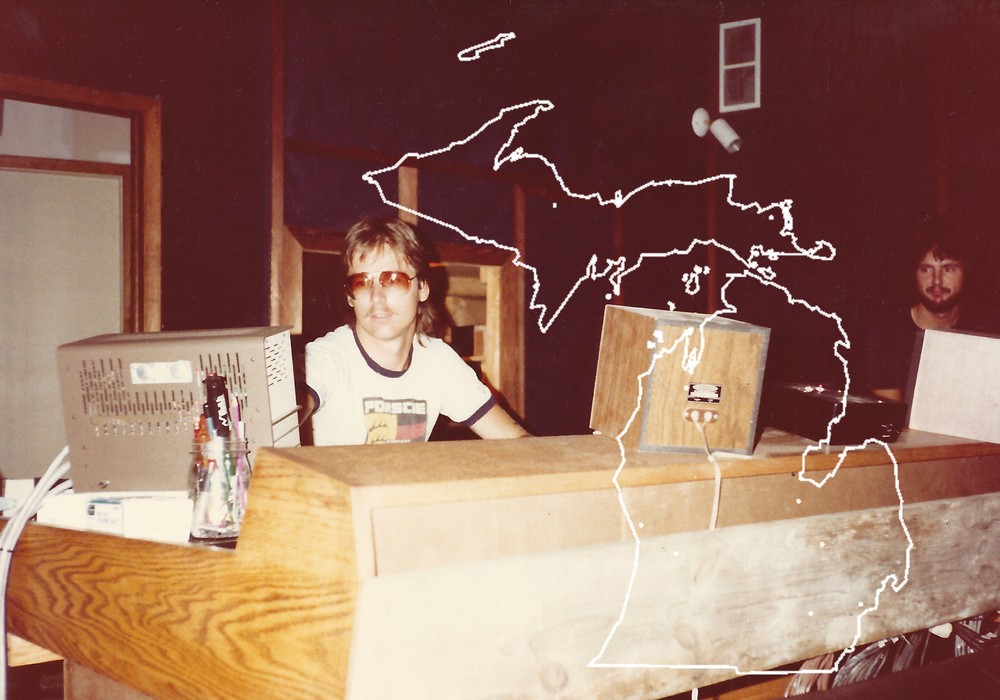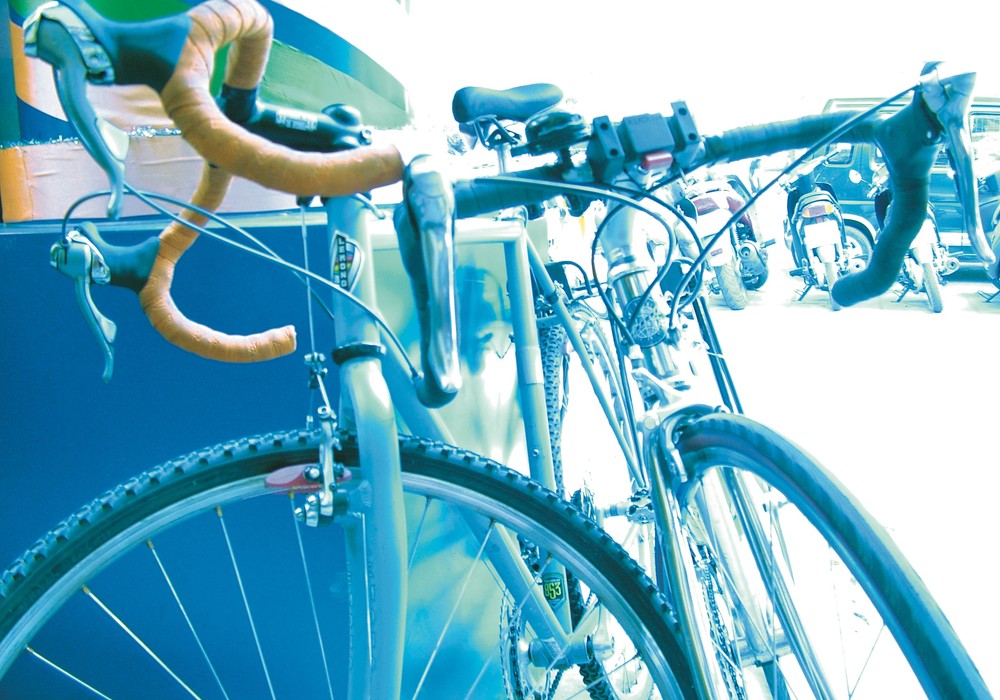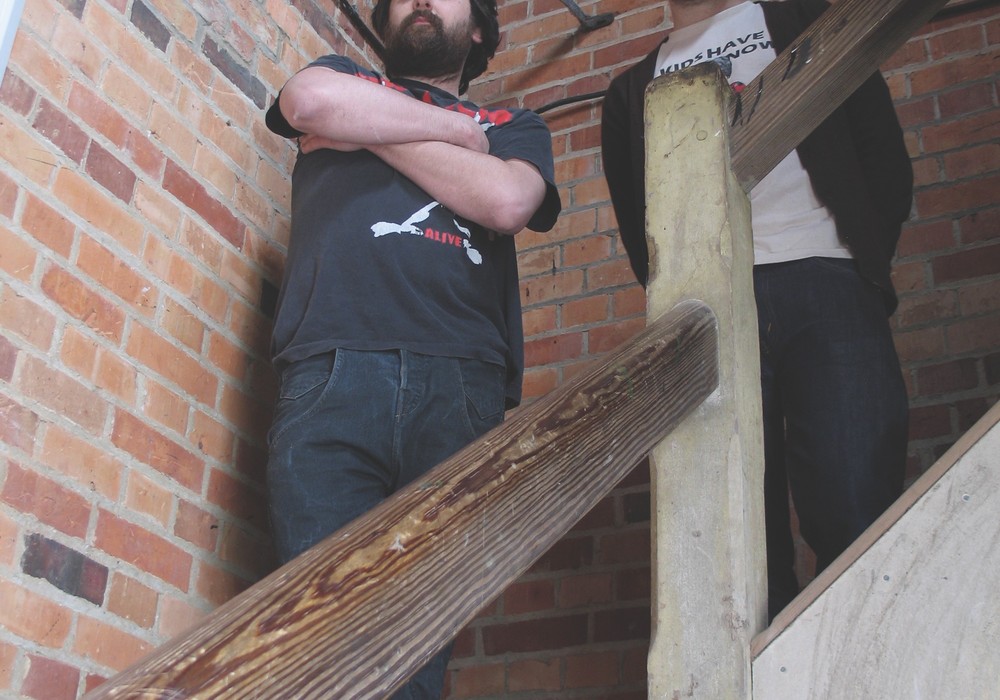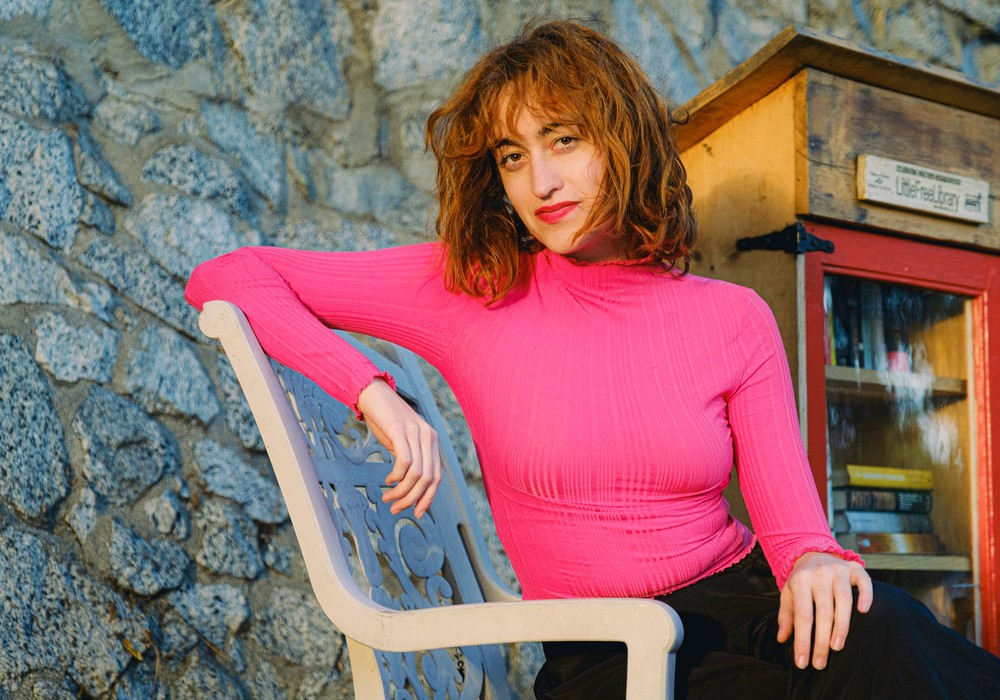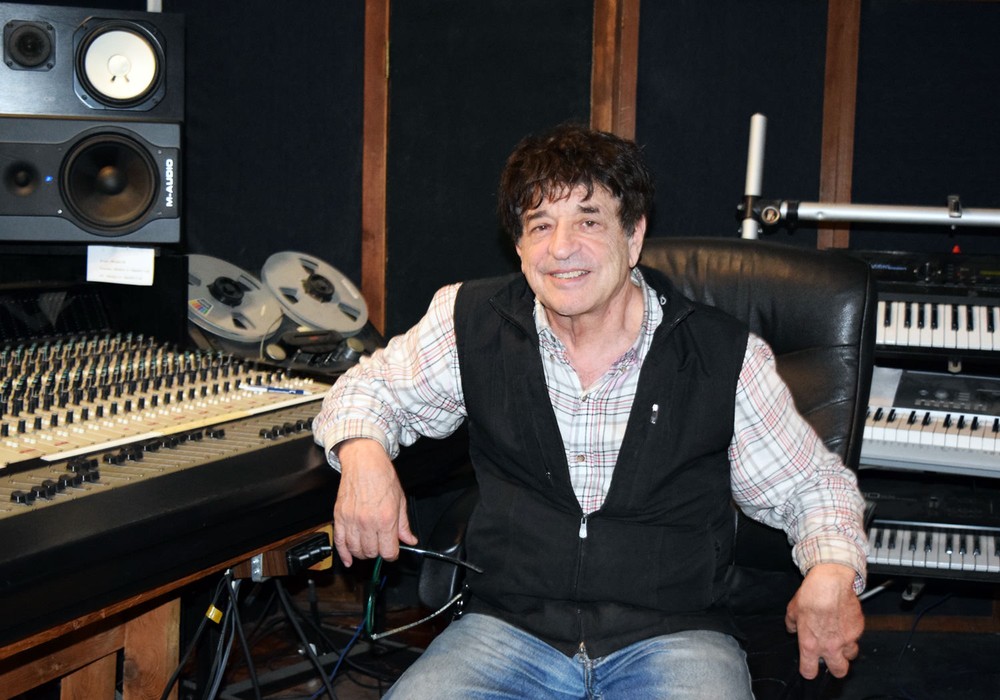When I was in high school, I knew a lot less about music than I do now, but even then Hüsker Dü's Zen Arcade seemed to jump out of my speakers. It certainly sounded a lot different from anything else that had crossed paths with my teenage ears. I remember reading in Rolling Stone about how quickly and cheaply it was recorded. The album's engineering credit included the terse identity 'Spot.' In the years since, I'd encountered like- minded punk groups of the era whose albums included Spot's name. It's hard for me to imagine anyone whose taste resembles mine not owning something he's recorded. When I moved to Chicago, I saw listings of Spot playing solo at clubs in town. I finally made it to one of these shows and interviewed the man known as Spot.
Spot first started recording at a young age when he was living in Hollywood. "It all started way back when, I bought an old Sony reel-to-reel recorder. I had borrowed recorders from people before, just sat down and taped myself. Just sounds, noises. I bought a Sony tape deck, I think it was an old model 350 reel-to-reel deck, 2 track, 1/4 track, stereo in both directions. I bought that and some microphones and tape." After that, "I had gotten my hands on one of the original Teac 3340s. Those machines, they caused a revolution. Those machines might be what created the whole independent record scene. I realized early on that really all you needed was a tape deck and some commitment. You could record pretty interesting stuff if you knew what you were doing."
In 1975, he moved to Hermosa Beach and got involved with the nascent Media Art studio. "When I moved there, I found out about a studio that was being built and that was exactly what I wanted to do, was to get myself in a studio situation so I could record myself. These guys were building a studio and I immediately saw that the potential was there, and I just started helping them." He came to be involved as staff engineer, which initially led to him recording a lot of projects in which he had little interest. "Can you say disco? There was a Mexican record label in town that did a whole lot of stuff. At that time, most of what was coming into the studio was either lame disco or lame light-rock songwriter stuff. Stuff that was really not that much fun to record."
"Everything was either light and easy or progressive and just overblown. Back then people were coming in wanting to sound just like something they heard on an Elton John or Linda Ronstadt record. I learned a lot from that, but I just couldn't understand the concept of trying to make something sound that much like something else."
"I had gotten so sick of these top 40 musicians who would come in and record these demos, where it would start off with a click track and everyone would play to the click track. There were a lot of songwriters who would come in, lay down a click track with a guide vocal and guitar track. There was this group of local musicians. They played in top 40 bands and had a lot of experience. They were good musicians. They would come in and start doing these song demos for various people. Basically it would start with the click track and what you'd call a single voice. Lots of times only one guy could come at a time, like the drummer would lay down his parts, and then everything else would get played on top of that, usually one track at a time. It was interesting, but damn it was tedious. And I got so sick of the single-finger synthesizer or String Machine pad that people would put on. I hated the sound. This was back when they were making, aside from Mini-Moogs and that, synthesizers that were starting to get really cheap sounding, and I hated the String Machine. I think it Roland made it. I'd love to maybe get my hands on one nowadays just so I can totally subvert it. I hated that stuff."
His favorite sessions of this era were jazz projects. Spot's explanation for liking jazz projects, oddly, was that he always liked rock n roll. For him, the jazz sessions involved live playing, which more closely matched his ideas than the carefully constructed productions which the singer-songwriters with whom he worked generally demanded. "They just didn't nit-pick over something." He fondly remembers working with a Dutch pianist named Rene van Helsdingen. "He would come over to the States where he had some players that he liked. They would always come in at midnight or so, whenever there was open time, and just record these compositions. He was a piano player, and he had these really good bass player and drummer working with him. I loved those sessions because you just set 'em up, get sounds and levels, hit 'record', and just let 'em play. They would take up one whole roll of tape with maybe one take of one piece."
"I recorded some classical players once where the session started at 7 in the morning. That was when I lived down at the beach and was skating. I had been out skating the whole night before or something. So I was all sweaty and sticky and stinky. I was living in the studio; I woke up at about 6 in the morning, it was during the winter, and it was cold. I walked down to the beach, where there was one of those showers you wash the sand off you. I walked down there to the shower and just took off my clothes and took some soap and took a shower in this cold water. I walked back to the studio and I was wide awake at that point. These guys come walking into the studio at 6:30 with their coffee, and I'm like [animated] 'Hello, how are you?' Sometimes getting up that early in the morning can really be productive."
He remembers Media Art as a "really great space. The place was like a block from the beach in good old surf city. It was upstairs and they had it on like a 5 year lease. The rent was something like $325 a month. We had the entire upstairs space. The studio itself, between the recording room and the control room was about 1200 square feet, which is a pretty good size. The rest of the place was at least 2000 square feet. There was another room that actually became a little overdub room. There was a bathroom that had been converted into a darkroom. I spent a lot of time in there. One room in the back was kind of like maintenance. There was a waiting room area, office space, and another back room."
The studio started with a 1 inch Sculley 8 track. "We had gotten a machine that had suffered a lot of abuse. I think it had been dropped out of a truck once and had been in a fire, so somebody completely cut away all the cabinetry of it and built a whole new custom cabinet for the transport and the electronics. We got it from Paramount Studios up in Hollywood, which then was on Santa Monica right off of Vine. It was pretty amazing." About 1977, the studio upgraded to a 3M model 56, a16 track 2 inch. "Those are cool machines. I don't really remember the order that we got these in. Eventually we went 24 track and had a 3M model 79, but then when we built the studio B, which is where I spent a lot of my time, we had this old Ampex MM1000, which was like the very first 16 track that was ever made. The size of a pizza oven, it was huge. When they're working right, you just can't beat 'em."
"I think the original board we had was a Speck. A guy named Vince Speck was building boards. He was up in the Valley. The first board, this was with 8 track, was a 16 channel board. Then we upgraded to the next board that he put out, which was also a 16 channel. I don't remember the model numbers on any of those boards. I know that the first one was black, the second one was blue. They worked. When we went to 16 track, we got a Tangent 32-16 console. To this day that's actually one of my favorite boards. They were not really fine boards, but there was something about the electronics where you could record really beefy basic tracks. For mixing it somehow didn't seem to do the job, although just bringing signals back through the monitor section of the board, avoiding the faders and all the EQ, was really clean and really punchy. Then after that, that studio lost the lease and was shut down."
"We were really lucky-we had some really good microphones. We had at least one pair of Neumann U67 tube condensers. Those things sound great. They look just like a Neumann U-87; basically the 87 is the later version of it, the solid- state version. We may have had about 4 of the 67s. And then we got some 87s, and then for a long time we were using the 87s just because they were more convenient. I remember on one session I needed another condenser mic, and I pulled out the 67 and until that moment I had never realized how good the 67 was. I had a chance to compare it. I was so used to the 87s that suddenly this thing sounded like, 'Man, my ears must have been clogged up all this time.' We also had, naturally, Shure SM 57s, EV RE20s. We had some AKG 414s, some of the original 414s, and the 451s. I guess they're now the 460 or something. They're just little pencil mics. Some Neumann KM84s. An assortment of dynamics, none of which I can remember. One of my favorite mics we had was a Shure SM53. They're silver, they don't look like a 57 or a 58. They're kind of slim, most of the body is slim, and then it kind of angles out into a kind of cylindrical head with a triple windscreen all around. They were real popular at one time. There was something about those mics, I always liked them. I liked 'em for vocals-they were real smooth. 57s and 58s were not that smooth, but a 53, and sometimes it's a 54 depending on which windscreen you screw on to it, those are real smooth. I've always liked those, recorded all kinds of stuff with them. We had a pair of Sony ECM 377s, condensers. They look like little Neumanns. Those were neat for overheads. Then there was a set of mics I really would love to get my hands on again, some Sony 56s. Also a condenser, they look kind of like a U-87 where you cut off part of the body of it. Those things had a sound to 'em that I can't describe."
"The downfall of the studio was that we had a terrible monitor system. We had these JBL 4320s. They were a 2-way system, 15 inch woofer and a horn tweeter. When you cranked them up, they sounded great, but because that 15 emphasized the bottom end so much, most of the mixes went out bass-shy. People got it sounding really great in the room and they'd take it away and there was no bottom end on it at all. We had some 4315s. I don't know if that was a 3 or 4 way system; they were really elaborate. They sounded too good. And of course Auratones. I learned to hate JBL monitors. At least 4311s, at least I knew what they sounded like. If a studio had 4311s, I wasn't happy, but at least I knew what I'd end up with. But, the monitors were just not up to snuff."
"Back then, there were a lot of people that insisted on mixing on headphones. A lot of producers, 'Oh, you gotta hear it on headphones.' I think that was more because they were smoking pot or whatever, and the headphones were real intimate. Before I ever got in the studio, I had a really good pair of headphones and would listen to stuff off the home stereo. There were occasionally some mixes that would amaze me; this was just listening to the radio. I remember one night I was laying in bed and I had the headphones on and the cord stretched across the room. Some song by BB King was on. Where the guitars were in the mix was just really cool. I remember, there was some old David Bowie stuff, that just really had really animated mixes. Not to impress you with the fact, just really good stuff." Despite these early experiences, Spot hates mixing with headphones. "I've tried mixing on headphones before, I can't do it. Mixes that I've made on headphones that I thought were just incredible, when you play them into the air, they sound like shit." He also complains about the physical inadequacy of the headphones he's used. "Most headphones that you find in the studio, they're inadequate. They break all the time."
As punk bands became more prevalent in Los Angeles, some of these bands started recording at Media Art. Spot remembers some of the early Dangerhouse bands recording at the studio. Sometimes he was the engineer on the records, but in a lot of cases he was not. In those cases, he "was just kind of like the engineer in there on call. Lots of times they'd bring their own engineer in. Some of those things Geza X was doing." He has trouble remembering which specific bands he engineered. "That's a tough one, because back then I was doing so many different sessions. I would do sometimes 4 and 5 sessions a day, back to back. So by the time these guys would come in at maybe midnight or 1 in the morning, I didn't really pay a whole lot of attention to who they were. At that point, I was tired, and lots of times because they had their own engineer, I wouldn't have anything to do. I would be out in the lobby asleep in the chair until someone needed me. I think I remember seeing names like the Bags and the Eyes. I know that the Plugz were in there at some point."
"At that time I wasn't just working up in the studio, I was doing a lot of photography back then, and a lot of writing and skating. I would spend just about all day skating and taking pictures. I would skate sometimes 20 miles a day. Between the studio and the skate shop down on the Strand, I was living between these 2 places. I remember all these experiences, so I don't remember all the people who were there." The increased chances to record bands that he cared about coincided with Spot's increasing enthusiasm for his work at the studio. "About '79 I started getting really serious about it, because the skating thing, it wasn't satisfying me as much. That's when I started making myself available to work with a few more bands." He says that the SST bands were his neighbors, and that "it was just kind of a natural progression of work that happened. Maybe I could just say we were all in the right place at the right time."
The punk bands' philosophies coincided well with his ideas about music. "Most of those bands and musicians were not interested in sounding like anything that was on the radio, which was fine, because I wasn't interested in trying to make things sound like stuff on the radio." Their approach to performing and recording also fit with the recording approaches which Spot preferred. "With the punk bands, I tried to put these people into the studio even without headphones. Just say, 'You put your amp there, you put your amp there' and just turn it up and just play. Let's not even worry about a headphone mix. They were playing so loud in the room it was like being in a practice room. Meanwhile I had everything close-mic'd and was able to deal with things." This approach was quite different from the ideas of many of his contemporaries in LA. "Everyone was worried about separation, they didn't want any leakage. Fortunately, we had recorded some things where we had to deal with leakage. There were some larger bands that had to play live. If you know how to set up the microphones, you can really minimize leakage with baffles and what-not. I wish I could remember what sessions they were, but there were some sessions that taught me that leakage is not a bad thing. Sometimes people who didn't have a lot of money, they had 5 hours to record 3 songs. So you had to set 'em up, wham bam, get the stuff down, so by the end of those 5 hours, they had a rough mix with vocals and the whole thing. I had to cut a lot of corners, so I just started going for the real basic stuff, and it was learning that, well, you can do this. This is the way all these old hit songs were recorded."
"I was always trying to do something new. Every session I tried to do something new." Sometimes these new ideas went horribly wrong, but he considers those his best learning experiences. "When you're first getting into recording, you have to try everything out. One thing is that you have to make mistakes. You have to record things that sound bad, only so that you can figure out what not to do. Most of recording is knowing what not to do, rather than knowing what to do. That's the thing I've learned." Despite this open-minded philosophy, his approach to "real basic stuff" led Spot to developing somewhat consistent techniques which he employed. "I've ended up kind of reversing that procedure and going back to a more standard approach. There's a reason there's a standard approach. It's not because you have to do it, it's because it works. At some point you have to find some kind of a formula that you can rely on. From doing all those other sessions, I learned a lot of the real standard approaches, and by god they work."
Spot's combination of standard approaches with trying new things left room for variations as his opinions changed and depending on the nature of his projects. One obvious example is his recording of bass guitars. "I know that there were periods of time when my ear would tell me that the amp sounded better, and then there are times when the direct sounded better." While his early session musician work usually involved running bass direct, a lot of punk and metal bands wanted to mic their amps. In a lot of cases, including many of the famous records he worked on, Spot "would usually both mic and go direct on the bass." For mic'ing bass amps, "I always liked RE20s and I may have used some Shure SM 87s and AKG 414s. I was never that fond of, a lot of people liked the Sennheiser 421 on bass, I've never been that crazy about it. It's used a lot. If I have my choice, whatever mic I use on the kick drum, I wanna use on a bass amp too. That seems to be a good combination. They're both picking up the same frequencies."
"When it comes to snare, I'm always going to start with a 57 and usually I'll end with a 57. One microphone I've always liked is the Sennheiser 441. I love it for snare. I've seen times when I was having problems getting a good snare sound, it just wasn't sounding thick enough, a 441 usually just fattens it up. Nice thing about a 441 is it's kind of hypercardioid. I like it for vocals too. Has a good kind of raspy sound to it. And they're great on guitar amps. I wish I had some of those again." Spot has a fairly spartan approach to miking a drum kit. "A lot of people like to mic snares from the top and bottom. I find that in most situations, the bottom mic is just, you don't need it. A separate hi-hat mic, you don't need. Just in the overheads and leakage into the other mics is plenty for the hi-hat, I find. I usually tried to not close mic cymbals. I usually tried to pull the mics back."
"Overheads, usually any good condenser does the job. Sometimes it's fun to put the overhead mics in an omnidirectional pattern. If you're in a live room, they can pick up the whole room, it can be really neat." He would use two mics for stereo, sometimes in an XY pattern, but "mostly I spread 'em out and put 'em in omni and make sure the phase is right on them."
Spot's general philosophy of compression fits into the bigger picture of the recording. "It's one of those things you just have to use your ear and have some kind of vision. I think that's really the key to it, just having some kind of vision on what you're doing. That way when you do something that's a real surprise, at least you've got a context you can relate to it in." He explains places where compression can fit into his general vision: "There've been times when I've compressed some drums. Sometimes you can get a really good, tight sound on toms by doing that, but I try not to. Compressing cymbals, overhead tracks can sometimes be a lot of fun, but it usu- ally sounds, you usually notice the compression at that point. Maybe that's what you want to do. I've compressed just about everything at some point or another. But I think that really, the best thing is just to try to record the tracks right in the first place, use the right mics and get good signals and then you don't have to use as much compression. Some things compression can really help. I've compressed guitar tracks before. Every once in awhile, a guitar track sounds better compressed."
"I've used so many compressors. The old Urei 1176s-I think that's the standard which every other compressor wants to live up to. The dbx 165 was a good one. It didn't seem to color the sound as much as squash it. Actually some of the less expensive compressors like dbx 160s and even the Alesis compressors, they actually do a pretty good job, but you just have to really be careful not to compress them too much. With the old Urei, you could really compress the hell out of them and it would still sound like a bass. But the cheaper ones, as long as you don't use too much compression, you're fine."
Any story about Spot would be incomplete without a discussion of some of his best-known work. He tends to remember big issues about the famous albums that he worked on, but not some of the minor details from the sessions. "There's a lot of stuff that happened and it just all went by so fast, I can't really say what it was anymore." Nonetheless, naming records did bring some great stories to mind.
The first band I asked about was Hüsker Dü, since they were my first exposure to his work. On at least one of their early records, "the bass itself had a cracked neck. There might be some songs where it kind of seems like everything is going out of tune, and that's why." Zen Arcade had problems with the very tape it was being recorded on. "Back in those days, everything was recorded on used tape. Studios in Hollywood would have these supplies of tape that they would just have to, all the old projects they'd have to just throw them out. So they sold all their used tapes, anywhere from 20 to 50 bucks a reel for the 2". And I had found some pretty good sources for used tape. Good tape, never had any problems with it-but that one! They were like these safety masters from a Bee Gees special. And for some rea- son they recorded some tracks on a 16 track machine and some tracks on a 24 track machine. When we got everything set up and then did the first playback, suddenly, at the end, as everything is fading out, you hear the Bee Gees singing. It was leaking between tracks. See, we didn't have a chance to bulk-erase those tapes before. What I would do is I would just run the tapes, erase the tapes while I'm setting up all the stuff. What I had to do, I had to take every track and erase it again. That slide that I was using tonight [for more conventional purposes with his guitar playing] was part of that recording. I had to put the tape on the machine, put every track in record, with the machine in the repro mode. I took that slide and just sat there by the machine and just held my finger on it and pushed the tape up, so that it physically slid up. I got it to this point where I didn't hear anything, and I just had to go on faith, and I had to do that with every single tape. I was sitting there by the machine, just holding my finger there for about 2 hours while the band went in the studio and took a nap."
"This was at Total Access. Media Art was gone at that point. It was just a studio that I worked at. They had, it must have been an MM-1200, and then later an ATR-124, Ampex machines, 2" 24." He explains the raw sound of the acoustic instruments quite simply. "The record was all recorded so fast, we didn't have time to make everything sound good."
New Day Rising had even bigger frustrations. "That was a pain in the ass session. When I walked in there for the first day, the studio wasn't put together. They were building a new room in the studio, is how we got the deal that we got. So, half the studio was filled up with boxes of equipment and shit from elsewhere, where they were doing the construction. And the board wasn't put together. They had gotten a new board or they had done maintenance. I walked in, half of the modules were out of the board and none of the outboard gear was hooked up. And where they put the board in the room, you could only hear one speaker. That was the first time I had to tell a studio, you have to move your board. I don't know what they were thinking, but of course we did get an incredible deal. It was probably an MCI tape deck."
He remembers a big difficulty from an early Minutemen session. "d. Boon's speakers in his amp were out-of-phase. 2 12" speakers, there were two different types of speakers. I remember once I recorded, I put a mic on each speaker, I was gonna record stereo. When I recorded stereo, I put it down to mono, the guitar just completely disappeared. 'd., we've got a problem here.' It didn't keep us from recording." His clarinet playing from the Minutemen radio broadcast, reissued on Politics of Time, did not present technical difficulties, but was memorable nonetheless. "I just walked in there and played. I think half-way through when I was doing that, I pulled the bell off of the clarinet. A friend of mine who was there watching it, he said that at one point, I didn't realize, huge gobs of spit were just dropping out of it. He said it was really gross."
"I like that record." was Spot's initial memory of Slovenly's Thinking of Empire. "I think that's one of, insofar as how albums ended up sounding, that's one of my favorites. I'll tell you one thing about it, I didn't get any sleep before doing it. I had just driven down from San Francisco and I couldn't hear a goddamn thing when I walked into the studio."
"That was at Music Lab in Hollywood. It's a stu- dio that, I don't think it exists anymore. It was a pretty nice place. I had a pretty good rapport with them; I got fairly good deals. They had a lot of gear; they had a really incredible mic selection. The guy who owned the studio actually owned one of the old original Telefunken's. The one with the Iron Cross pilot light on it, I think he actually owned one that Hitler himself spoke on. At least that's what he said. They had a lot of old Neumann's and AKG mics."
He remembers a Neumann M 49, which he used there (though not with Slovenly) as "one of the best sounding vocal mics I've ever used in my life. I used that on some techno thing that some guy had hired me for. And I had never used one and it was just there. I said 'Well, let me try this one.' Man, it sounded great."
The Descendents' Milo Goes to College stands out to him because he had enough time to record vocals properly. His biggest memory of that record, though, is his difficulty in reaching the studio. "I think most of the sessions I was riding the bus to it. I think that was when I had the car that all the water poured down the carburetor."
The first Meat Puppets record was a challenging experience, but he's happy with the results. "That recording is the epitome of what studio recording is not about. They had this man- ager at that time, and I had set the guys up in a reasonable studio fashion, with some separation and what-not. And they were not gettin' it, they just weren't playing well. They just couldn't get into a groove. So the manager just goes into the room and pushes all the instruments together and says, "Well let's make it like your practice room", and so that thing is leakage-city. And that record sounds great. I wasn't gonna argue with him. Anyone with any sense would have just walked out." Their second album was recorded more conventionally.
One of the last punk albums which Spot recorded was the Texas band Not for Sale, whose album was on Rabid Cat. When the opportunity came up to record them, it motivated him to move to Texas, where he still lives. "I couldn't live in LA anymore, and ended up getting evicted out of a good house, because the owner decided to tear it down and build condos, and at that point I had had it with LA. I just threw everything in my van and said I'm just going to go to Austin, do this job, and worry about it later, and I stayed there." Spot remembers Cedar Creek, where he recorded the album, as a "great studio."
"I blew out the high-end driver in one of the speakers. They had these baby Westlakes, really great speakers, but sensitive. They had a midrange driver that was really bright, so, well, I just didn't notice it. I know that's gonna sound terrible. We mixed the whole album, and then when we took the stuff home, and we'd gotten some great mixes, so we thought. We listened to it at home, and there was something really lopsided about it. So, I had to bite the bullet on that one. I mean, it was my fault. I had to remix the whole damn thing. I really tried to save it. I was hoping that maybe it could have been saved in the mastering. It was too far gone. I had a long conversation with John Golden, who was mastering my stuff then. I sent him a copy of it, and he said he could make it better, but it's not gonna be what you mixed. It'll never be that." The album's mixes continued to cause problems. When the band received the new test pressings from John Golden, they were slower than the cassette dubs that they'd been listening to. The tape deck in the studio had been broken, and the band's dubs thus played faster in their own decks. They preferred the sped-up version to their own performances, and asked for the record to be re-mastered at a faster speed. Spot disagreed with their opinions, but the finished album plays faster than the original recordings.
When he moved to Austin, Spot's enthusiasm for working with punk bands had faded, and he, ironically, sought recording work in the singer- songwriter community. A record which stands out to him from this period was for a songwriter named Terry Clark. "He's a English/Irish song- writer who about 10 or 12 years ago came here to the states to play and was basically 'adopted' by the Lubbock songwriter contingent-guys like Butch Hancock, Joe Ely, Jimmy Dale Gilmore, Terry Allen. He hooked up with J. D. Foster, an ex- bassist for Dwight Yoakam, whom I had gotten to know as a then-current member of the True Believers. At that time I was looking for new, non- punk, types of projects to work on. I mean, you can't keep doing the same thing and expect to be happy. Anyway, J.D. wanted to get into producing, and Terry Clark was gonna be his first project. I was pretty flattered and excited when he asked me to engineer the sessions. It was a very Nashville- style session where the musicians learned the tunes right there in the studio, and I had a great time hanging out with them. Some of the sidemen were Flaco Jimenez, Erik Hokkanen, David Grissom, Rich Brotherton-all very well known players in the 'Texas music' realm."
"We did the whole album over one weekend at the Firestation in San Marcos. The studio had actually been a fire station in an old brick building. It was a very big, live room. Their claim to fame at the time was that they had one of the first Sony tape-based digital multitrack machines-I'm pretty sure we recorded analog, however. And they had a fancy-shmancy board. Neve? Trident? Damn, I don't remember, that, well, had a lot of problems. Every module seemed to have something on it that didn't work unless you chanted mantra 558 while driving a midsize Chevy backward on a Tuesday morning that followed the new moon, but only if the last eclipse could be seen from dryer number 4 at Pearl's Beauty Salon on Main Street if it's a day when Flo wasn't complaining about her husband Harry stayin' out all nite. And the patchbay had more shorts and intermittency than any patchbay I've ever worked on. Oh well, at least we got the record done."
"The studio was real proud of some MIDI drum voice rack module. They tried to get us to use it, but we really didn't need it. On one song, though, the drummer found the box that it came in and started playing it with brushes, and we all said in unison, 'That's the sound we want! Let's mic it up!' Yeah, it was a very fun, memorable recording ses- sion. I wish I had a copy of the album ['Call Up a Hurricane'] but it was one of those European deals that went outta print a long time ago."
"One of the best things I think that happened when I got sick of doing studio stuff, I really, after about years and years of studio stuff, I went back to playing around with 4-tracks. Got an X15 Fostex, and I was still working in studios at this time. This was around the time I did the Slovenly record. And I started playing around with the X15, recording my own ideas and that. I just like the way a lot of those tracks sound so much better than studio stuff. I really got into that real per- sonal thing again. And it was one of the best things that ever happened to me. It made me re- align my ears with my whole philosophy on things again. I've got one of those Tascam 238's, 8 track cassette. I'm putting out an album; everything on this album is recorded either on this 8 track or on the old Fostex 4 track."
"I've got a real minimal setup. I've got some good outboard gear-nothing fancy but good stuff. Microphones, I've got a bunch of 57s, some 58s, some direct boxes. I've got some old Sony condensers. There was a Sony condenser that they were making back in the days when the Teac 4-track was like the big thing. I don't remember the number of those but I've got a pair of them. Somehow I ended up with some omni capsules from some old Altec condensers which screw right on. Either the Altecs were made by Sony or the Sonys were made by Altec. All of that stuff serves me well. I've got this amplifier, it's a solid-state Fender with a preamp out. I've recorded so many tracks through that thing. Using it as a preamp and just going right to tape. It's a Studio Lead. I have a whole slew of old tube amps, but I proba- bly use that Studio Lead more than any amp I've ever owned. I've used it as a mic preamp. It's just a matter of, just tweaking it in. I've actually got- ten some pretty, nothing outstanding, but I've gotten some good tracks that go down to tape really well."
Aside from recording himself, Spot doesn't do much engineering any more. "I'll put it this way, I tried not to record anybody for a long time, but lately there have been some situations that have proved worthwhile. I just did this band called the Shindigs in Austin. What happened was that they came to me with some stuff that they had recorded on 16 track ADAT. It was recorded kind of quick and haphazardly and was basically a practice that they recorded. And they wanted to take the good stuff and finish it and record a few new ones. And I liked the band and I liked the people and I said "Sure, let's do it". It was the worst situation I've ever had with an ADAT. One of the machines would not sync up. I've always hated the way you have to wait for one machine to catch up with the other. From analog, you go back and you just hit play, so that you're sitting there waiting for it to go. They have some older ADATs and one of 'em needed a lot of servicing. We lost an entire night. That's the one project that I've done recently." He elaborated even more on ADATs. "VHS is a shitty format; I don't think it's good for video, I don't think it's good for audio. I wish that Alesis had never used the VHS format for ADAT. If someone gave me an ADAT machine I'd be happy, but they suck."
Spot's amazing memory for his years of recording reflects the diverse experiences of a veteran engineer. It's amazing with everything we did discuss, we didn't even get to the Big Boys, the Dicks, St. Vitus, Overkill, Saccharine Trust, and so many more notable bands that he's worked with. It was also a surprising but fun experience to match the name I've seen on so many records with the musician I saw on stage. His fingerpicked guitar style and Loudon Wainright- like narrative songs are light years away from the records with which I associate his name. The most interesting part for me, though, was learning that someone who made such unusual sounding records during the punk era had once worked regularly with songwriters who wanted to sound like Elton John.
